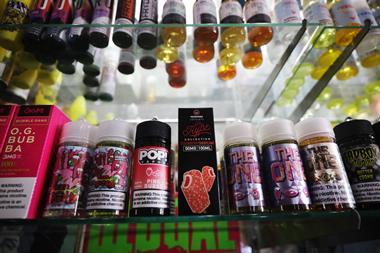As research suggests that e-cigarettes may expose vapers to harmful chemicals, Rebecca Trager finds that governments are catching up with regulations
The global e-cigarette market is expected to reach over $50 billion (£35 billion)) by 2025, growing annually by more than 22% from 2015, and yet there is no epidemiological data on their long-term health effects. While several recent studies indicate that they might release toxic chemicals, many experts question the scientific soundness of that research.
Electronic cigarette use is increasing at an explosive rate as an alternative to smoking tobacco cigarettes, especially among young people, and governmental bodies in many countries are grappling with how to regulate these products amid emerging scientific evidence of their potential harms.
The principle behind e-cigarettes is to offer a substitute for smoking without all of the known harmful constituents of tobacco cigarettes, whose global market is currently projected at over $740 billion.
While traditional cigarettes burn tobacco leaves, e-cigarettes are battery operated devices that vapourise a flavoured nicotine solution so that it can be inhaled by the user. Tobacco cigarettes have over 6000 compounds, and more than 60 of these are known carcinogens. In contrast, e-cigarette cartridges typically contain nicotine and flavourings like cherry or chocolate, as well as another ingredient to produce the aerosol, such as propylene glycol or vegetable glycerine.
‘The user is inhaling a vapour … as opposed to the smoke from when you light a tobacco cigarette on fire,’ explains Thomas Kiklas, chief financial officer and co-founder of the Tobacco Vapor Electronic Cigarette Association. ‘It creates a product that is much less harmful than a tobacco cigarette,’ he says.
Experts like David Hammond at the University of Waterloo in Ontario, Canada, whose research focuses on interventions to reduce chronic disease, agree. ‘You don’t have combustion with e-cigarettes, you use vapourisation,’ he says. ‘They almost certainly pose substantially less harm than smoked products.’
In fact, the UK government watchdog Public Health England concluded in August 2015 that vapour products are around 95% less hazardous to human health than tobacco cigarettes, based on a review of the available evidence. But this conclusion proved controversial, with many public health researchers questioning the underlying science and publicly accusing the organisation of basing its estimate on industry-funded research.
Smoke without fire?

However, a dozen public health organisations in the UK, including Cancer Research UK and the Royal College of Physicians, came to Public Health England’s defence. The groups issued a joint statement on 15 September 2015 arguing that there is no circumstance in which it is better for a smoker to continue smoking rather than switch to vaping.
Since the e-cigarette device first hit the market in 2004, the product’s prevalence and use has risen dramatically. A recent poll carried out by Thompson Reuters and others revealed that about 10% of US adults are current e-cigarettes users, as of mid-2015. In Great Britain, an estimated 2.6 million adults currently use e-cigarettes (just over 4%), up from about 700,000 (around 1%) in 2012.
‘These staggering increases in such a short time underscore why FDA intends to regulate these additional products to protect public health,’ stated Mitch Zeller, who directs the US Food and Drug Administration’s (FDA) Center for Tobacco Products, in April 2015.
Government agencies and some public health groups have voiced concern that e-cigarette use is on the rise, but what has gone less noticed is that this increase has been accompanied by a drop in cigarette smoking. For example, the Disease Control and Prevention (CDC) found that past-month cigarette smoking in US high school students fell from 15.8% to 9.2% between 2011 and 2014. But current e-cigarette use among US high school students tripled from 4.5% in 2013 to 13.4% in 2014, and use grew among middle schoolers from 1.1% to 3.9% in that same time period, according to data from the CDC.
‘At a time when e-cigarettes are literally quadrupling in use among youth, that was the largest annual year to year decline in youth smoking that we have ever experienced,’ says Michael Siegel, a community health scientist at Boston University in the US. He says e-cigarettes appear to be diverting people away from traditional cigarettes, which is ‘a great thing, because that is what’s killing people’.
Unsurprisingly, the vaping industry is eager to cite figures from public health charity Action on Smoking and Health (ASH) showing that between 2012 and 2014, the number of e-cigarette users in Great Britain rose from 700,000 to 2.1 million – a three-fold increase – and juxtapose that with figures from Smoking in England indicating that tobacco cigarette use continues to steadily decline, falling from almost a quarter of adults in 2007 to 18% in 2015. However, ASH clarifies that its tobacco smoking data for Great Britain specifically show a less significant drop from 22% in 2006 to 19% in 2013.
Despite the usage figures, polls have revealed a public perception that e-cigarettes are dangerous. For example, in a recent survey by the Harvard University School of Public Health in the US nearly two-thirds of American adults polled said they believe e-cigarettes are harmful to the health of vapers – less than tobacco cigarettes, but more than marijuana.
DNA damage
This opinion has been fuelled by several different studies published in the last 12–18 months. For example, researchers at Portland State University in the US released findings in January 2015 that e-cigarette vapour can contain the known human carcinogen formaldehyde at levels five to 15 times higher than regular cigarettes.
You have to keep things in perspective. The reality is that, if anything, what this study shows is that electronic cigarettes are a lot safer than smoking
However, experts inside and outside the industry have questioned the scientific soundness of the study. They argue that the research is specious because it required the e-cigarette unit to be actually burned before formaldehyde became an issue. The vapourisation process takes place at 150–180ºC, and the scientists apparently took samples at up to 400°C. Under normal vaping conditions, the study actually showed that formaldehyde is not a concern.
When the vapour device in the study was used at the realistic setting of 3.3V, formaldehyde was not detected, notes Gregory Conley, president of the American Vaping Association. He claims that the researchers increased the voltage to 5.0V and continued having a machine take puffs for 3–4 seconds, which caused extreme overheating and the production of formaldehyde.
Beyond formaldehyde, a new study by Harvard researchers published in December 2015 determined that more than 75% of the e-cigarette varieties tested contained diacetyl – a flavouring chemical that has been linked to a severe respiratory disease known as bronchiolitis obliterans, or ‘popcorn lung’. Specifically, the Harvard team detected concerning levels of diacetyl in 39 of the 51 e-cigarette flavours tested.
But some professionals like Siegel note that daily exposure to diacetyl from smoking tobacco cigarettes is 750 times higher, on average, than exposure to diacetyl from vaping. ‘You have to keep things in perspective,’ he says, noting that even smokers do not appear at higher risk of developing popcorn lung.
‘The study interprets the findings in an alarmist way to make it sound like it is a terrible problem, and that vapers all over the country are going to be coming down with popcorn lung,’ Siegel explains. ‘The reality is that, if anything, what this study shows is that electronic cigarettes are a lot safer than smoking.’
But e-cigarettes have been linked to more than formaldehyde and diacetyl. Another recent research paper that is raising alarm bells, written by researchers at Penn State University in the US, suggests that e-cigarettes can cause DNA damage. The study, led by public health sciences and pharmacology professor John Richie, showed that e-cigarettes produce highly reactive free radicals, which are associated with cell damage and cancer.
The levels of free radicals that were produced when the e-cigarette’s heating coil heats the nicotine solution to very high temperatures were more than what would be expected from a heavily air-polluted area but less than what you might find in cigarette smoke, according to Richie.
Looking closer
‘Our findings suggest that these e-cigarettes need a closer look,’ Richie says, noting that significantly more research is needed, including clinical trials, to provide the strong scientific data to confirm the findings.
Experts agree that the Penn State study does add free radicals to the list of safety concerns that the FDA and other regulatory agencies need to consider with regard to e-cigarettes, but some assert that no real conclusions can be drawn about the actual health effects of e-cigarettes from this particular study.
‘The question is whether the conditions that they used are realistic with respect to actual e-cigarette users,’ says Stephen Hecht, a researcher at the University of Minnesota in the US, whose laboratory studies the mechanisms of metabolic activation and DNA modification by carcinogens in tobacco products.
Meanwhile, researchers at the Veterans Affairs San Diego Healthcare System in the US led by Jessica Wang-Rodriguez and Weg Ongkeko tested two popular e-cigarette products and published findings in January 2016 that they damaged cells in ways that could lead to cancer. The scientists found that the cells treated with extract from the e-cigarette vapour were more likely to show DNA damage and die.
‘Our study strongly suggests that electronic cigarettes are not as safe as their marketing makes them appear to the public,’ the researchers wrote. They did add that further studies are needed to ‘definitively determine the long-term effects of e-cig usage’, and whether the DNA damage shown in their research as a result of e-cigarette exposure will lead to mutations that ultimately result in cancer.
The exposed cells showed several forms of damage, including DNA strand breaks, which indicates that the cellular repair process doesn’t work right and sets the stage for cancer. The researchers also found that exposure to e-cigarettes with nicotine caused worse damage, but even the nicotine-free vapour negatively altered cells.
Wang-Rodriguez says previous research has shown that nicotine can damage cells, but her team found that other variables can do so as well. ‘It’s not that the nicotine is completely innocent in the mix, but it looks like the amount of nicotine that the cells are exposed to by e-cigarettes is not sufficient by itself to cause these changes,’ she says. ‘There must be other components in the e-cigarettes that are doing this damage. So we may be identifying other carcinogenic components that are previously undescribed.’
But the VA research is facing similar criticism as the Penn State study. ‘This is just a study of cell cultures, and it doesn’t necessarily have any relevance to the clinical situation, the real life situation,’ says Siegel. ‘You can’t just take results from this cell culture and extrapolate it to conclude that e-cigarettes are going to be toxic to people when they are actually used by humans.’
Cell culture conjecture
Siegel says the findings simply prove that something in the e-cigarette aerosol caused toxicity to these epithelial cells in culture, and he notes that the study found that the cytotoxicity of tobacco smoke appeared to be much higher than that of the e-liquids. ‘A very, very small amount of the tobacco smoke was enough to kill all of these cells, whereas it took a much higher amount of the e-liquid,’ he notes.

Indeed, there were so many complaints about the Veterans Association’s press release on the study concluding that e-cigarettes ‘are no better than smoking regular cigarettes’, that the agency actually ended up issuing a ‘correction’ to clarify that the lab experiments did not find that e-cigarette vapour was as harmful to cells as cigarette smoke. ‘In fact, one phase of the experiments, not addressed in the news release, found that cigarette smoke did in fact kill cells at a much faster rate,’ the agency admitted.
Wang-Rodriguez herself emphasises that this was simply a laboratory study based on cell lines, which is usually the first step to looking at the potential harms. ‘It is not comparable to an actual study of live animals or humans,’ she explains. Her team has proposed a similar study with small animals, probably either rodents or rabbits, to examine tissue damage after exposure to e-cigarettes. The project has yet to be approved or funded, but Wang-Rodriguez hopes to commence the work later this year or early next year.
But not all the news is bad. A research study from University of Minnesota that examined the levels of toxicant and carcinogen metabolites in the urine of e-cigarette users, compared with the urine of tobacco cigarette smokers as well as people who don’t smoke or use e-cigarettes, reported positive results in January 2015. The project, co-led by Hecht, determined that the levels of these dangerous substances were no higher for e-cigarette users than for non-smokers, with the exception of nicotine, whereas in smokers the level was significantly higher.
‘We found extremely low levels – in most cases – of these biomarkers in the urine of the e-cigarette smokers compared to the cigarette smokers,’ says Hecht. ‘The levels of e-cigarette users were similar to non-smokers and non-e-cigarette users,’ he confirms.
Hecht says these findings are consistent with previous analyses that have indicated the levels of toxicants and carcinogens in e-cigarette vapour and liquids are considerably lower than in cigarette smoke.
Nevertheless, Hecht acknowledges that this study does not represent a side-by-side comparison. The smoker data and the non-smoker data that his team used were taken from previous studies conducted at the university. ‘That needs to be done much more thoroughly,’ he says. ‘There is still a considerable amount of work to be done.’
Regulations


The US and the EU appear to be the only countries where e-cigarettes are available for retail sale. Their retail sale in other nations, like Canada and Australia, is illegal.
When it comes to regulating e-cigarettes, Europe, and the UK in particular, appear to be ahead of the pack. In November 2015, the UK Medicines and Healthcare Products Regulatory Agency (MHRA) granted a licence for e-Voke, an e-cigarette developed by the British American Tobacco-owned company Nicovations, to be marketed as a smoking cessation device. This means that e-Voke could be prescribed on the National Health Service for patients trying to quit smoking.
Nicovations says it has not published any clinical trials on e-Voke, and also says the e-cigarette was not granted a licence based on a bioequivalence with similar products like an already available nicotine inhaler. E-Voke is not on the market, and Nicovations says it is currently reviewing ‘the commercialisation and consumer resonance’ of the product.
Nevertheless, many experts believe that the MHRA’s action could pressure the regulatory agencies in other countries, like the US FDA, to take a similar approach.
Hammond says the MHRA’s granting of the licence for e-Voke recognises that e-cigarettes fundamentally do the same thing as other regulated medicines like nicotine patches and gums – deliver nicotine without the smoke, which can help people quit smoking. ‘The advantage of regulating nicotine as a medicine is that there is greater control over how it can be marketed,’ Hammond explains. ‘The UK is a few years ahead of most other countries,’ he says. ‘But I would expect that those other countries will ultimately follow a similar path.’
But Jonathan Foulds, a professor of public health sciences and psychiatry at Penn State College of Medicine in the US who conducts research on tobacco and health, says it might not make sense for e-cigarette companies in the US to follow e-Voke’s path. ‘This technology is moving ahead, and it takes years and hundreds of millions of dollars to start from ground zero and get a licence like e-Voke did,’ he says. ‘You could jump through all of those hoops, or you can just put it on the market right now with no restrictions in the US.’
E-cigarettes and other nicotine vapour products will be regulated in Europe under the EU’s Tobacco Products Directive, effective May 2016. This will, among other things, limit the strength of e-liquids to 2% nicotine, require that e-cigarettes contain similar package warnings to those on cigarettes, and require manufacturers and importers of e-cigarettes and e-liquids to submit to authorities available scientific studies on toxicity, addictiveness and attractiveness of their products, in particular involving ingredients and emissions. In addition, the commission must submit a report to the European Parliament and the Council by 20 May 2016 on the potential risks to public health associated with the use of refillable e-cigarettes.
Meanwhile, in the US the FDA is moving to regulate e-cigarettes and e-liquids. In October 2015, the agency proposed a rule to include e-cigarettes under its authority to regulate certain tobacco and nicotine-containing products. Under the proposal, companies producing and wanting to sell such products would have to register with the FDA, and submit product and ingredient listings, among other things.
FDA fairness questioned
The FDA says that this new ‘deeming’ rule will allow it to issue future regulations for e-cigarettes, including those intended to reduce their harmfulness. To date, the agency says it has not been able to fully assess the public health impacts of unregulated tobacco products. For example, the FDA notes that some testing of e-cigarette cartridges has revealed significant variability in nicotine content and the presence of chemical constituents that raise concerns of toxicity.
The science is still out about whether or not the process of heating metal during e-cigarette use presents a risk
Observers from inside and outside the industry say the forthcoming FDA regulation will treat vapour products far more harshly than tobacco cigarettes. While cigarettes on the market before 2009 are grandfathered in, the FDA regulation would require every vapour product on the market to go through a retroactive premarket approvals process that could cost millions of dollars per product. The concern is that it could shut out all but a small handful of the companies backed by big tobacco or Wall Street.
‘The kinds of studies that will be required are incredibly expensive and I don’t think it’s feasible that any of these smaller companies are going to be able to successfully do these applications,’ says Siegel. ‘The electronic cigarette market is going to contract severely because the only companies that can afford these applications are going to be the tobacco companies and possibly a few of the largest independent e-cigarette manufacturers.’
Clearly, e-cigarettes present a much safer alternative to smoking, but a clear understanding of what dangers they may pose remains elusive and is dependent on further research, which is desperately needed.
British American Tobacco (BAT) itself has concerns about e-cigarettes. A company spokesman tells Chemistry World that one ‘unknown’ is if the process of heating metal during e-cigarette use can generate corrosion over time that should not be inhaled. ‘The science is still out about whether or not that presents a risk,’ the spokesman says. ‘As you are inhaling the vapour, you could also be inhaling these things as well.’
Public health experts and researchers in the field agree about the importance of ensuring that efforts to protect the public don’t wind up protecting the American tobacco industry from competition.













No comments yet